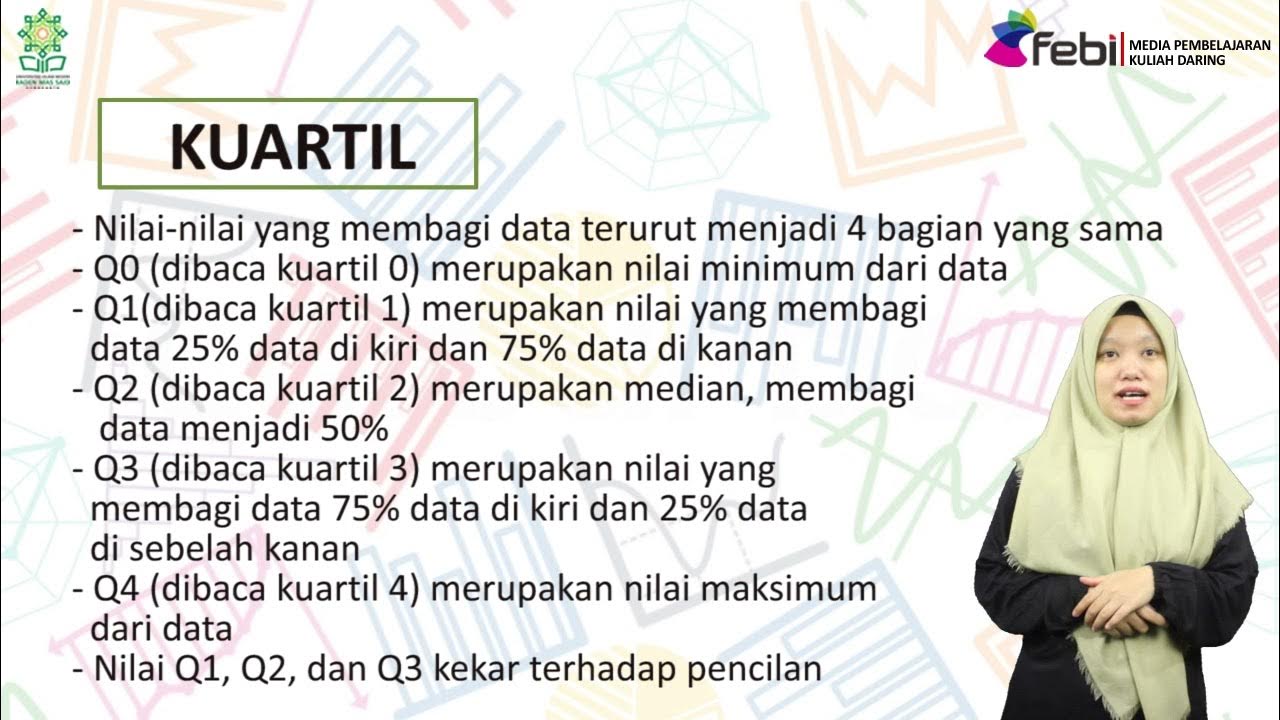Cara menentukan nilai varian (Ragam) dan Standar deviasi (Simpangan baku) data tunggal dan kelompok
Summary
TLDRThis educational video script discusses the concepts of variance and standard deviation for both individual data points and grouped data. It guides viewers through calculating the mean, variance, and standard deviation for a set of individual numbers and then explains the process for grouped data using a frequency table. The tutorial includes step-by-step instructions for completing a table with various calculations, emphasizing the importance of understanding these statistical measures.
Takeaways
- 📚 The video discusses the concepts of variance and standard deviation for both individual data points and grouped data.
- 🔢 To calculate variance for individual data, the formula involves summing the squared differences from the mean.
- 📈 The standard deviation is the square root of the variance, providing a measure of data dispersion.
- 📋 For grouped data, the process starts by summing the frequencies and calculating the mean using the formula: mean = (sum of Fi * Xi) / total frequency.
- 🧮 The video provides a step-by-step guide on how to fill out a table with additional columns for calculations specific to grouped data.
- 📊 The tutorial explains how to calculate the mean for grouped data, which is essential for further calculations of variance and standard deviation.
- 📐 The video demonstrates how to calculate the variance for grouped data using the formula: variance = sum of (Fi * (Xi - mean)^2) / total frequency.
- 📏 The standard deviation for grouped data is similarly calculated by taking the square root of the variance.
- 📝 The script emphasizes the importance of understanding the formulas and steps to accurately determine variance and standard deviation.
- 🌐 The tutorial is intended to be beneficial and easy to understand, with the hope that it can be a source of knowledge for viewers.
Q & A
What is the main topic discussed in the video?
-The main topic discussed in the video is the calculation of variance and standard deviation for both individual data and grouped data.
What is the first step in calculating variance for individual data?
-The first step in calculating variance for individual data is to find the mean (average) of the given numbers.
How is the mean calculated for a set of numbers?
-The mean is calculated by summing all the numbers and then dividing by the count of the numbers.
What is the formula for variance for individual data?
-The formula for variance (s^2) for individual data is the sum of the squared differences between each number and the mean, divided by the count of numbers (n).
How do you calculate the standard deviation from variance?
-The standard deviation (s) is calculated by taking the square root of the variance (s^2).
What is the first step in calculating variance for grouped data?
-The first step in calculating variance for grouped data is to sum the frequencies of the data.
How is the mean calculated for grouped data?
-For grouped data, the mean (X̄) is calculated using the formula X̄ = (Σ Fi * Xi) / Σ Fi, where Fi is the frequency and Xi is the midpoint of each group.
What additional columns are needed to calculate variance for grouped data?
-Additional columns needed include Xi, Fi * Xi, Xi - X̄, (Xi - X̄)^2, and Fi * (Xi - X̄)^2.
What is the formula for variance for grouped data?
-The formula for variance (s^2) for grouped data is the sum of the frequencies multiplied by the squared differences between each group's midpoint and the mean, divided by the total number of data points (n).
How is the standard deviation calculated for grouped data?
-The standard deviation for grouped data is calculated by taking the square root of the variance (s^2).
What is the purpose of calculating variance and standard deviation in statistics?
-Variance and standard deviation are measures of dispersion that help to understand the spread of a dataset and the degree of variation or dispersion of the data points around the mean.
Outlines

Cette section est réservée aux utilisateurs payants. Améliorez votre compte pour accéder à cette section.
Améliorer maintenantMindmap

Cette section est réservée aux utilisateurs payants. Améliorez votre compte pour accéder à cette section.
Améliorer maintenantKeywords

Cette section est réservée aux utilisateurs payants. Améliorez votre compte pour accéder à cette section.
Améliorer maintenantHighlights

Cette section est réservée aux utilisateurs payants. Améliorez votre compte pour accéder à cette section.
Améliorer maintenantTranscripts

Cette section est réservée aux utilisateurs payants. Améliorez votre compte pour accéder à cette section.
Améliorer maintenantVoir Plus de Vidéos Connexes

Statistika Part. 4 | Ukuran Penyebaran, Ragam, Varian, Simpangan Rata-rata, Simpangan Baku

Statistika Bagian 7 - Simpangan Baku dan Varian Data Tunggal dan Data Berkelompok

KULIAH STATISTIK (6) - UKURAN VARIABILITAS DATA

Ilmu Data #5 - Varians dan Standar Deviasi

Variance and Standard Deviation for Grouped Data

Statistika Deskriptif Ukuran Pemusatan dan Penyebaran Data | Zulfanita Dien Rizqiana, S.Stat., M.Si.
5.0 / 5 (0 votes)
